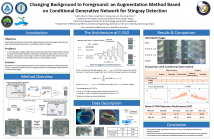
The International Conference on Image Processing (ICIP), sponsored by the IEEE Signal Processing Society, is the premier forum for the presentation of technological advances and research results in the fields of theoretical, experimental, and applied image and video processing. ICIP has been held annually since 1994, brings together leading engineers and scientists in image and video processing from around the world. Visit website.

- Read more about CHANGING BACKGROUND TO FOREGROUND: AN AUGMENTATION METHOD BASED ON CONDITIONAL GENERATIVE NETWORK FOR STINGRAY DETECTION
- Log in to post comments
Image processing has been a popular tool for biological researches. Detecting specific animals in aerial images captured by an UAV is a crucial research topic. As the rapid progress of deep learning (DL), it has been a popular approach to many image classification and object detection tasks. However, DL usually requires a large set of training samples to learn the network weights, while the biological image materials are often insufficient to fulfill the demand.
- Categories:
 11 Views
11 Views
- Read more about Double Complete D-LBP with Extreme Learning Machine Auto-Encoder and Cascade Forest for Facial Expression Analysis
- Log in to post comments
Although the obtained accuracy on some lab-controlled facial expression datasets has been very high, the recognition of facial expressions in wild environments is still a challenging problem. Local Binary Patterns (LBP) is a widely used operator in facial expression recognition. However, there are few variations of LBP operators specifically designed for facial expression recognition. In this paper, we propose a novel representation approach called the Double Complete d-LBP (Double Cd-LBP) according to the characteristics of facial expressions.
- Categories:
 10 Views
10 Views
We presents a no-reference (NR) image sharpness metric based on a visual sensitivity model. We propose that MaxPol convolution kernels are close approximation to this model and capable of extracting meaningful features for image sharpness assessment. Equipped by these kernels, we develop an efficient pipeline to evaluate the out-of-focus level of input images by decomposing the first and third order image differentials. The associated kernels are regulated in higher cutoff frequencies to balance out the information loss and noise sensitivity.
- Categories:
 117 Views
117 Views
- Read more about HYPERSPECTRAL IMAGERY DENOISING VIA REWEIGHED SPARSE LOW-RANK NONNEGATIVE TENSOR FACTORIZATION
- Log in to post comments
- Categories:
 11 Views
11 Views
- Read more about FAST AND ROBUST VANISHING POINT DETECTION ON UN-CALIBRATED IMAGES
- Log in to post comments
This paper presents a novel algorithm for fast and effective vanishing point detection. Once line segments in an input image are detected by LSD algorithm, the proposed method filters out outlier line segments. The remaining line segments are then over-clustered, and each cluster is assigned to 5 different types. According to the assigned type, each cluster is re-merged by applying different criteria, and the re-merged clusters generate hypotheses for vanishing points.
- Categories:
 14 Views
14 Views
- Read more about DEEPSSH: DEEP SEMANTIC STRUCTURED HASHING FOR EXPLAINABLE PERSON RE-IDENTIFICATION
- Log in to post comments
poster.pdf
- Categories:
 55 Views
55 Views
Spatial pooling over convolutional activations (e.g., max pooling or sum pooling) has been shown to be successful in learning deep representations for image retrieval. However, most pooling techniques assume that every activation is equally important, and as a result they suffer from the presence of uninformative image regions that play a negative role as regards matching or lead to the confusion of particular visual instances. To address this issue, we propose a trainable building block that steers pooling to local information important to the task at hand.
TP.L2.4.pdf
- Categories:
 55 Views
55 Views
Fly Local Sensitive Hashing (FLSH) is a biomimetic data-independent hashing method inspired by the mechanism of odor processing system in drosophila. In this paper,we propose a novel Randomized Sampling-based Fly Local Sensitive Hashing (rs-FLSH) to model the randomness occurred during the establishment of synapses between neurons.Significant performance improvement can be achieved by applying a novel randomized sampling scheme in rs-FLSH,in which the sample rate is modeled by a Gaussian random variable rather than a fixed value in FLSH.
- Categories:
 23 Views
23 Views
- Read more about Light Field Image Restoration for Vision in Scattering Media
- Log in to post comments
Recovering information from contrast-limited, SNR-limited, color-attenuated images in a scattering medium is of paramount importance for the autonomous functioning of robotic agents. The task is challenging due to the transient state of the medium, unknown medium parameters and in many cases the need for fully autonomous operation. This work presents a target-less, calibration-less method for restoring underwater light field images and requires no explicit model of the medium.
ICIPPoster.pdf
- Categories:
 28 Views
28 Views
- Read more about Closed-form Solution of Simultaneous Denoising and Hole Filling of Depth Image
- Log in to post comments
This paper presents a novel Time-of-Flight (ToF) depth recovery algorithm minimizing a new quadratic energy function utilizing depth and infrared data. The proposed energy function consists of a filtering term and a reconstruction term to remove noise and fill holes simultaneously in a depth image. In the filtering term, a new multilateral weight is introduced by fully using available spatial, depth, and infra¬red information.
- Categories:
 14 Views
14 Views